Ever since the first Japanese immigrants arrived in Canada in the late 19th century, Japanese Canadians have created their communities in their settlement areas. They came to a new country to find employment and to improve their economic situation. In Open Collections, we have many resources about the history and lives of Japanese Canadians. This post will introduce some of our digitized items and explore four towns where Japanese Canadians resided before relocation.
Why did Japanese people migrate to Canada in early 1900s?
Our digitized book from the Chung Collection, Japanese contribution to Canada, a summary of the role played by the Japanese in the development of Canadian commonwealth (1940) explains the background of Japanese migration. Japan ended its seclusion policy and started to establish treaties with other countries in 1854. In 1884, the Japanese government allowed its laboring-class citizens to emigrate abroad, which resulted in big waves of Japanese immigration to Canada. Having little English-language ability, most of the immigrants engaged in the primary industries which required small degree of training, such as fishing, lumbering, mining, and railroading.
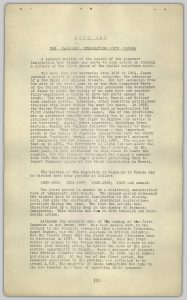
Japanese contribution to Canada, a summary of the role played by the Japanese in the development of Canadian commonwealth, 1940.
Vancouver, BC: Powell St.
Many of the immigrants from Shiga, Japan, who experienced flooding, resided in the Vancouver area. They initially found employment at the Hastings Mill area, along the south shores of Burrard Inlet, and gradually started their business in the Powell Street area (Japantown, Nihonmachi, Paueru Gai, パウエル街) in today’s Downtown Eastside. Despite enduring the race riots in 1907, the community itself continued to grow.
Steveston, BC
The first Japanese arrived at Steveston was known to be Gihei Kuno(工野儀兵衛). People from his hometown, Mio district in Wakayama, Japan had made their livings by fishing and farming, but they had faced severe economic hardship in the late 19th century. On his first visit to Steveston, he was fascinated by the amount of salmon in Fraser river, and returned back to Japan to urge people to go to Canada to fish. As a result, Steveston became the second largest Japanese-Canadian settlement area before the Second World War. His recruitment also made Mio district the largest single sources of Japanese emigrants to Canada.
A digitized book from the Chung Collection, Japanese contribution to Canada, a summary of the role played by the Japanese in the development of Canadian commonwealth (1940), notes that the Japanese population in the area was estimated to be around 4,500 in 1900.
Woodfibre, BC
Woodfibre was a small company town operating a pulp mill between early 1900s and 2006. According to Takeo Ujo Nakano’s memoir, Within the barbed wire fence : a Japanese man’s account of his internment in Canada (1980), half of the population of Woodfibre was Japanese, and majority of them were single men. Every month, the Japanese employees were assigned to a pulp-loading duty when a Japanese freighter docked at the port. They gathered and listened to the latest news about their home country.
The digitized book Japanese contribution to Canada, a summary of the role played by the Japanese in the development of Canadian commonwealth (1940) also describes Woodfibre as one of the large centres where Japanese formed a large portion of the employment population:
The Japanese workers in Woodfibre are practically all employees of B. C. Pulp and Paper Company, Limited. They first found their way to this town during the War. In 1918, 59 were working in the mills; in 1920, 100; by 1930, the total number of Japanese employed was 230; but in 1934 it had decreased to 157. Now, 200 are working. (pp.16)
The book also argues that the amount of wages for Japanese workers were lower than the Whites in the lumber, paper and pulp industries. However, it was still seven times higher than the average wage in Japan, which motivated them to continue working there and send money to their home.
Port Alberni, BC
Port Alberni on Vancouver Island had a small settlement of Japanese Canadians. They engaged in the logging and lumber operation at the McLean Mill. McLean Mill/Banbridge School was built in 1929 served as a community center, and half of the students were Japanese Canadians. However, due to the Japanese relocation, the school closed permanently in 1942.
If you are interested in other Japantowns, Japanese-Canadian’s lifestyle before and after their relocation, and Canadian attitudes towards Japanese immigrants, the following are the examples of helpful historical resources in Open Collections:
Collections
Books and Documents
- Japanese contribution to Canada, a summary of the role played by the Japanese in the development of Canadian commwealth, 1940. (in the Chung Collection)
- The Octopus of the East and its Menace to Canada : The truth about the Japanese present occupancy and what it will mean to Canada within the next 25 years (by Thomas, F. Leighton, in the Chung Collection)
- RETURN Of correspondence relating to fraudulent naturalization Japanese, 1901. (by British Columbia Legislative Assembly, in the BC Sessional Papers)
Subject Headings
References
- Kawahara, N. (2018). Perspectives and issues concerning research of Japanese fisheries history in Canada. The Ritsumeikan Bungaku, 656, 121-135. Retrieved from http://www.ritsumei.ac.jp/acd/cg/lt/rb/656/656PDF/kawahara.pdf
- History (Powell street festival society)
- Kobayashi, A., Rose-Redwood, R., Aagesen, S., & The Landscapes of Injustice Research Collective. (2018). Exile: Mapping the migration patterns of Japanese Canadians exiled to Japan in 1946. Journal of American Ethnic History, 37(4), 73-89. Retrieved from https://www.jstor.org/stable/10.5406/jamerethnhist.37.4.0073
- Japanese Canadian History (National Association of Japanese Canadians)
- History of emigrants to Canada (Mihama city
- About The Project (Woodfibre LNG Ltd.)
- Payday at Woodfibre (part 4) – Japanese Canadians, defined as “enemy aliens,” suffer internment and loss of jobs and property (by Bob Ingraham, December 2, 2013)
- Within the barbed wire fence : a Japanese man’s account of his internment in Canada (1980)
- Nisei: Nikkei connection to McLean Mill (by Chuck Tasaka, February 20, 2017 in the Bulletin)
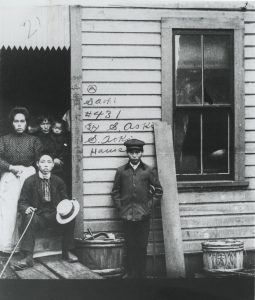
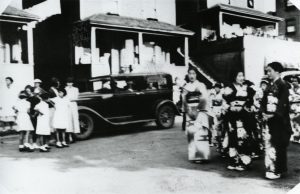
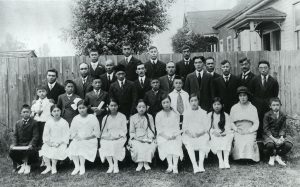
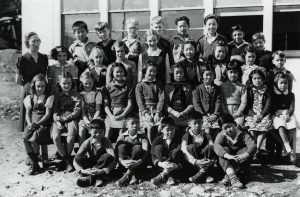




Have you explored the Japanese community in Ruskin, BC? There were two classrooms of students in the Ruskin school but when the Japanese families were relocated there were only eight students left – my husband being one of them.
Hello Donna,
Thank you very much for your comments. We didn’t explore Ruskin in this blog post because we don’t have any photographs of the community in Open Collections. However, in the cited book in Open Collections, we found a paragraph about Japanese labour in Ruskin and other areas in Maple Ridge: https://open.library.ubc.ca/collections/chung/chungpub/items/1.0114625#p20z-2r0f:ruskin We really appreciate you sharing your knowledge and your husband’s experience.
Risa
– Digital Projects Student Librarian
Have you any comments or pictures etc. of the Japanese in Port Alice, a similar town to Woodfibre. I have a picture of a group of young men standing outside their community hall.
Hello, thank you for your interest in UBC Open Collections.
Based on a quick search of our digitized collections, it is uncertain if there are any materials related to the Japanese community of Port Alice. There are mentions of Port Alice in Open Collections, as indicated by this search result: https://open.library.ubc.ca/search?q=%2522port%2520alice%2522&p=0&sort=0&view=0&perPage=2&circle=n&dBegin=&dEnd=&c=2&ubc_repo_label=Digitized%20Collections
These results include a few issues of the Tariku Nippo, a Japanese-Canadian newspaper of the early to mid-twentieth century.
Its possible that if you searched through the Japanese Canadian Photographs Collection: https://open.library.ubc.ca/collections/jphotos you may find images that are of the Japanese-Canadian community in Port Alice, but are not labelled as such simply because there were no descriptions included with the items, or the individuals describing the items did not have the knowledge to recognize the location in which the photographs were taken.
If you would like more information on this collection, I would recommend getting in touch with UBC Rare Books and Special Collections, as they hold the collection and therefore likely have much more knowledge of it than we do. https://rbsc.library.ubc.ca/contact-form/
Thank you again for your interest in UBC Open Collections.
Just curious that you had a picture of Japanese Canadians in Port Alice, my Grandfather went there in 1922 from Tottori ken and where he was to meet his father who died 40 days after his arrival. He left taking the ashes. I do not think that he returned
Do you have any information on the Japanese community at Knobb Hill near Brittania mine townsite? My mother recalls families being removed from there when internment occurred.
Hello Carolyn,
Thank you for your comment and interest in our collections.
Based on a quick search of our digitized collections, it is uncertain if there are any materials related to the Japanese community at Knob Hill near Britannia mine townsite. There are mentions of Internment and Knob Hill in Open Collections, as indicated by this search result:
https://open.library.ubc.ca/search?q=%22Internment%22%20AND%20%22Knob%20Hill%22
Please visit the Japanese Canadian Photographs Collection to conduct keyword searches: https://open.library.ubc.ca/collections/jphotos
You may find images that are of the Japanese-Canadian community at Knob Hill near Britannia mine townsite, but are not labelled as such because there were no descriptions included with the items, or the individuals describing the items did not have the knowledge to recognize the location in which the photographs were taken.
Thank you again for taking the time to contact us and we wish you all the best with your search.
Best regards,
Digitization Centre Team
Hi! Do you please have any information on the Japanese community in Squamish? Or any other immigrant (non-European descent) communities? Thank you!
Hi Barbora,
Thank you for your comment and interest in learning more about immigrant communities in Squamish. For information on the Japanese community, we recommend exploring the resources available at the Nikkei National Museum, which holds extensive archives on Japanese Canadian history.
Additionally, you are welcome to browse our Open Collections for materials related to immigrant communities, or you can contact our Subject Librarian at the Asian Library for further research assistance tailored to your interests.
Thank you again for reaching out, and happy researching!
Best regards,
Digitization Centre Team